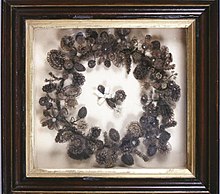

This article includes a list of general references, but it lacks sufficient corresponding inline citations. Please help to improve this article by introducing more precise citations. (November 2017) (Learn how and when to remove this message)
|

Alock of hair is a piece or pieces of human hair that are usually bunched or tied together in some way. A lock of hair can be on a person's head, or have been cut from the head. When attached to the head, a lock of hair generally refers to a tress, curl, or ringlet of hair.[1] When cut from the head, a lock of hair may be kept for its symbolic value.

Locks of hair often carry symbolic value and have been utilized throughout history in various religious, superstitious, sentimental and romantic contexts. Examples include:
The following hairstyles make use of lock(s) for symbolic or aesthetic reasons.
The following locks of hair are notable for their cultural or historical significance: